A Systematic Analysis of Research on Arcobacter: Public Health Implications from a Food–Environment Interphase Perspective
Abstract
1. Introduction
2. Materials and Methods
2.1. Sources of Arcobacter Research Data
2.2. Bibliometric Analysis of the Data
2.3. Analysis of the Growth Rate of Arcobacter Research
2.4. Assessment of Arcobacter Research Scientific Networks
2.5. Software Analysis
3. Results and Discussion
3.1. The Description of the Bibliometric Data
3.2. Arcobacter Research Trend
3.3. Publication Growth
3.4. Contributing Authors and Participating Countries in Arcobacter Research
3.5. Publication Journals
3.6. Collaborations Done in Arcobacter Related Research
3.7. Conceptual Frameworks in Arcobacter Research
3.8. Description of Studies Published in 2020
4. Conclusions
5. Study Strength and Limitations
Supplementary Materials
Author Contributions
Funding
Institutional Review Board Statement
Informed Consent Statement
Conflicts of Interest
References
- Giacometti, F.; Lucchi, A.; Di Francesco, A.; Delogu, M.; Grilli, E.; Guarniero, I.; Stancampiano, L.; Manfreda, G.; Merialdi, G.; Serraino, A. Arcobacter butzleri, Arcobacter cryaerophilus, and Arcobacter skirrowii circulation in a dairy farm and sources of milk contamination. Appl. Environ. Microbiol. 2015, 81, 5055–5063. [Google Scholar] [CrossRef]
- Lehner, A.; Tasara, T.; Stephan, R. Relevant aspects of Arcobacter spp. as potential foodborne pathogen. Int. J. Food Microbiol. 2005, 102, 127–135. [Google Scholar] [CrossRef] [PubMed]
- Vandamme, P.; De Ley, J. Proposal for a New Family, Campylobacteraceae. Int. J. Syst. Bacteriol. 1991, 41, 451–455. [Google Scholar] [CrossRef]
- Ramees, T.P.; Dhama, K.; Karthik, K.; Rathore, R.S.; Kumar, A.; Saminathan, M.; Tiwari, R.; Malik, Y.S.; Singh, R.K. Arcobacter: An emerging food-borne zoonotic pathogen, its public health concerns and advances in diagnosis and control-A comprehensive review. Vet. Q. 2017, 37, 136–161. [Google Scholar] [CrossRef]
- Di Noto, A.M.; Sciortino, S.; Cardamone, C.; Ciravolo, C.; Napoli, C.; Alio, V.; Arculeo, P.; Oliveri, G.; Costa, A. Detection of Arcobacter spp. In food products collected from Sicilia region: A preliminary study. Ital. J. Food Saf. 2018, 7, 72–75. [Google Scholar] [CrossRef]
- Banting, G.; Figueras Salvat, M.J. Arcobacter. In Water and Sanitation for the 21st Century: Health and Microbiological Aspects of Excreta and Wastewater Management (Global Water Pathogen Project), Part 3: Specific Excreted Pathogens: Environmental and Epidemiology Aspects–Section 2: Bacteria; Rose, J.B., Jiménez-Cisneros, B., Pruden, A., Ashbolt, N., Miller, J., Eds.; Michigan State University Press: East Lansing, MI, USA, 2017. [Google Scholar]
- ICMSF Microorganisms in Food. Microbiological testing in food safety management. International Commission on Microbiological Specifications for Foods. In Microorganisms in Foods 7; Kluwer Academic Publishing: New York, NY, USA; Springer International Publishing: Cham, Switzerland, 2002; pp. 1–30. [Google Scholar]
- Collado, L.; Figueras, M.J. Taxonomy, epidemiology, and clinical relevance of the genus Arcobacter. Clin. Microbiol. Rev. 2011, 24, 174–192. [Google Scholar] [CrossRef]
- Kim, H.M.; Hwang, C.Y.; Cho, B.C. Arcobacter marinus sp. nov. Int. J. Syst. Evol. Microbiol. 2010, 60, 531–536. [Google Scholar] [CrossRef]
- Levican, A.; Collado, L.; Figueras, M.J. Arcobacter cloacae sp. nov. and Arcobacter suis sp. nov., two new species isolated from food and sewage. Syst. Appl. Microbiol. 2013, 36, 22–27. [Google Scholar] [CrossRef]
- Park, S.; Jung, Y.T.; Kim, S.; Yoon, J.H. Arcobacter acticola sp. nov., isolated from seawater on the East Sea in South Korea. J. Microbiol. 2016, 54, 655–659. [Google Scholar] [CrossRef] [PubMed]
- Jalava, K.; Rintala, H.; Ollgren, J.; Maunula, L.; Gomez-Alvarez, V.; Revez, J.; Palander, M.; Antikainen, J.; Kauppinen, A.; Räsänen, P.; et al. Novel Microbiological and Spatial Statistical Methods to Improve Strength of Epidemiological Evidence in a Community-Wide Waterborne Outbreak. PLoS ONE 2014, 9, e104713. [Google Scholar] [CrossRef] [PubMed]
- Talay, F.; Molva, C.; Atabay, H.I. Isolation and identification of Arcobacter species from environmental and drinking water samples. Folia Microbiol. 2016, 61, 479–484. [Google Scholar] [CrossRef] [PubMed][Green Version]
- Merga, J.Y.; Royden, A.; Pandey, A.K.; Williams, N.J. Arcobacter spp. isolated from untreated domestic effluent. Lett. Appl. Microbiol. 2014, 59, 122–126. [Google Scholar] [CrossRef] [PubMed]
- Lee, C.; Agidi, S.; Marion, J.W.; Lee, J. Arcobacter in Lake Erie beach waters: An emerging gastrointestinal pathogen linked with human-associated fecal contamination. Appl. Environ. Microbiol. 2012, 78, 5511–5519. [Google Scholar] [CrossRef]
- Fong, T.T.; Mansfield, L.S.; Wilson, D.L.; Schwab, D.J.; Molloy, S.L.; Rose, J.B. Massive microbiological groundwater contamination associated with a waterborne outbreak in Lake Erie, South Bass Island, Ohio. Environ. Health Perspect. 2007, 115, 856–864. [Google Scholar] [CrossRef] [PubMed]
- Phillips, C.A. Arcobacters as emerging human foodborne pathogens. Food Control 2001, 12, 1–6. [Google Scholar] [CrossRef]
- Wesley, I.V.; Baetz, A.L.; Larson, D.J. Infection of cesarean-derived colostrum-deprived 1-day-old piglets with Arcobacter butzleri, Arcobacter cryaerophilus, and Arcobacter skirrowii. Infect. Immun. 1996, 64, 2295–2299. [Google Scholar] [CrossRef] [PubMed]
- Van Driessche, E.; Houf, K.; Vangroenweghe, F.; Nollet, N.; De Zutter, L.; Vandamme, P.; Van Hoof, J. Occurrence and strain diversity of Arcobacter species isolated from healthy Belgian pigs. Res. Microbiol. 2004, 155, 662–666. [Google Scholar] [CrossRef]
- Corry, J.E.L.; Atabay, H.I. Poultry as a source of Campylobacter and related organisms. J. Appl. Microbiol. 2001, 90, 96S–114S. [Google Scholar] [CrossRef]
- Houf, K.; On, S.L.W.; Coenye, T.; Mast, J.; Van Hoof, J.; Vandamme, P. Arcobacter cibarius sp. nov., isolated from broiler carcasses. Int. J. Syst. Evol. Microbiol. 2005, 55, 713–717. [Google Scholar] [CrossRef][Green Version]
- Eifert, J.; Castle, R.; Pierson, F.; Larsen, C.; Hackney, C. Comparison of sampling techniques for detection of Arcobacter butzleri from chickens. Poult. Sci. 2003, 82, 1898–1902. [Google Scholar] [CrossRef]
- Kabeya, H.; Maruyama, S.; Morita, Y.; Kubo, M.; Yamamoto, K.; Arai, S.; Izumi, T.; Kobayashi, Y.; Katsube, Y.; Mikami, T. Distribution of Arcobacter species among livestock in Japan. Vet. Microbiol. 2003, 93, 153–158. [Google Scholar] [CrossRef]
- Rivas, L.; Fegan, N.; Vanderlinde, P. Isolation and characterisation of Arcobacter butzleri from meat. Int. J. Food Microbiol. 2004, 91, 31–41. [Google Scholar] [CrossRef]
- Serraino, A.; Giacometti, F.; Daminelli, P.; Losio, M.N.; Finazzi, G.; Marchetti, G.; Zambrini, A.V.; Rosmini, R. Survival of arcobacter butzleri during production and storage of artisan water Buffalo Mozzarella Cheese. Foodborne Pathog. Dis. 2013, 10, 820–824. [Google Scholar] [CrossRef]
- Mottola, A.; Bonerba, E.; Bozzo, G.; Marchetti, P.; Celano, G.V.; Colao, V.; Terio, V.; Tantillo, G.; Figueras, M.J.; Di Pinto, A. Occurrence of emerging food-borne pathogenic Arcobacter spp. isolated from pre-cut (ready-to-eat) vegetables. Int. J. Food Microbiol. 2016, 236, 33–37. [Google Scholar] [CrossRef]
- Leoni, F.; Chierichetti, S.; Santarelli, S.; Talevi, G.; Masini, L.; Bartolini, C.; Rocchegiani, E.; Naceur Haouet, M.; Ottaviani, D. Occurrence of Arcobacter spp. and correlation with the bacterial indicator of faecal contamination Escherichia coli in bivalve molluscs from the Central Adriatic, Italy. Int. J. Food Microbiol. 2017, 245, 6–12. [Google Scholar] [CrossRef]
- Mottola, A.; Bonerba, E.; Figueras, M.J.; Pérez-Cataluña, A.; Marchetti, P.; Serraino, A.; Bozzo, G.; Terio, V.; Tantillo, G.; Di Pinto, A. Occurrence of potentially pathogenic arcobacters in shellfish. Food Microbiol. 2016, 57, 23–27. [Google Scholar] [CrossRef] [PubMed]
- Andersen, M.M.E.; Wesley, I.V.; Nestor, E.; Trampel, D.W. Prevalence of Arcobacter species in market-weight commercial turkeys. Antonie van Leeuwenhoek, Int. J. Gen. Mol. Microbiol. 2007, 92, 309–317. [Google Scholar] [CrossRef] [PubMed]
- Rasmussen, L.H.; Kjeldgaard, J.; Christensen, J.P.; Ingmer, H. Multilocus sequence typing and biocide tolerance of Arcobacter butzleri from Danish broiler carcasses. BMC Res. Notes 2013, 6, 322. [Google Scholar] [CrossRef]
- Giacometti, F.; Lucchi, A.; Manfreda, G.; Florio, D.; Zanoni, R.G.; Serraino, A. Occurrence and genetic diversity of Arcobacter butzleri in an artisanal dairy plant in italy. Appl. Environ. Microbiol. 2013, 79, 6665–6669. [Google Scholar] [CrossRef]
- Serraino, A.; Florio, D.; Giacometti, F.; Piva, S.; Mion, D.; Zanoni, R.G. Presence of Campylobacter and Arcobacter species in in-line milk filters of farms authorized to produce and sell raw milk and of a water buffalo dairy farm in Italy. J. Dairy Sci. 2013, 96, 2801–2807. [Google Scholar] [CrossRef]
- Serraino, A.; Giacometti, F. Short communication: Occurrence of Arcobacter species in industrial dairy plants. J. Dairy Sci. 2014, 97, 2061–2065. [Google Scholar] [CrossRef]
- Hausdorf, L.; Neumann, M.; Bergmann, I.; Sobiella, K.; Mundt, K.; Fröhling, A.; Schlüter, O.; Klocke, M. Occurrence and genetic diversity of Arcobacter spp. in a spinach-processing plant and evaluation of two Arcobacter-specific quantitative PCR assays. Syst. Appl. Microbiol. 2013, 36, 235–243. [Google Scholar] [CrossRef]
- Shah, A.H.; Saleha, A.A.; Zunita, Z.; Murugaiyah, M.; Aliyu, A.B.; Jafri, N. Prevalence, Distribution and Antibiotic Resistance of Emergent Arcobacter spp. from Clinically Healthy Cattle and Goats. Transbound. Emerg. Dis. 2013, 60, 9–16. [Google Scholar] [CrossRef][Green Version]
- Moher, D.; Liberati, A.; Tetzlaff, J.; Altman, D.G.; Altman, D.; Antes, G.; Atkins, D.; Barbour, V.; Barrowman, N.; Berlin, J.A.; et al. Preferred reporting items for systematic reviews and meta-analyses: The PRISMA statement. Ann. Intern. Med. 2009, 151, 264–269. [Google Scholar] [CrossRef]
- Ekundayo, T.C.; Okoh, A.I. A global bibliometric analysis of Plesiomonas-related research (1990–2017). PLoS ONE 2018, 13, e0207655. [Google Scholar] [CrossRef] [PubMed]
- Jaccard, P. Distribution of alpine flora in the basin of Dranses and in some neighboring regions. Bull. Soc. Vaud. Sci. Nat. 1901, 37, 241–272. [Google Scholar]
- Saitou, N.; Nei, M. The neighbor-joining method: A new method for reconstructing phylogenetic trees. Mol. Biol. Evol. 1987, 4, 406–425. [Google Scholar] [CrossRef]
- Aria, M.; Cuccurullo, C. Bibliometrix: An R-tool for comprehensive science mapping analysis. J. Informetr. 2017, 11, 959–975. [Google Scholar] [CrossRef]
- Ruiz-Rosero, J.; Ramirez-Gonzalez, G.; Viveros-Delgado, J. Software survey: ScientoPy, a scientometric tool for topics trend analysis in scientific publications. Scientometrics 2019, 121, 1165–1188. [Google Scholar] [CrossRef]
- Shuaib, W.; Acevedo, J.N.; Khan, M.S.; Santiago, L.J.; Gaeta, T.J. The top 100 cited articles published in emergency medicine journals. Am. J. Emerg. Med. 2015, 33, 1066–1071. [Google Scholar] [CrossRef] [PubMed]
- Swales, J.M. Research Genres Exploration and Application; Cambridge University Press: Cambridge, UK, 2004. [Google Scholar] [CrossRef]
- Lillis, T.; Curry, M.J. Academic Writing in a Global Context: The Politics and Practices of Publishing in English; Routledge: London, UK, 2010. [Google Scholar]
- López-Navarro, I.; Moreno, A.I.; Burgess, S.; Sachdev, I.; Rey-Rocha, J. Why publish in English versus Spanish?: Towards a framework for the study of researchers’ motivations. Rev. Esp. Doc. Cient. 2015, 38, 1–16. [Google Scholar] [CrossRef]
- Collado, L.; Guarro, J.; Figueras, M.J. prevalence of Arcobacter in meat and shellfish. J. Food Prot. 2009, 72, 1102–1106. [Google Scholar] [CrossRef] [PubMed]
- Hassan, A.K. Detection and Identification of Arcobacter species in Poultry in Assiut Governorate, Upper Egypt. J. Adv. Vet. Res. 2017, 7, 53–58. [Google Scholar]
- Shange, N.; Gouws, P.; Hoffman, L.C. Campylobacter and Arcobacter species in food-producing animals: Prevalence at primary production and during slaughter. World J. Microbiol. Biotechnol. 2019, 35, 146. [Google Scholar] [CrossRef]
- Okaiyeto, K.; Ekundayo, T.C.; Okoh, A.I. Global research trends on bioflocculant potentials in wastewater remediation from 1990 to 2019 using a bibliometric approach. Lett. Appl. Microbiol. 2020, 71, 567–579. [Google Scholar] [CrossRef] [PubMed]
- Ekundayo, T.C.; Okoh, A.I. Systematic assessment of mycobacterium avium subspecies paratuberculosis infections from 1911–2019: A growth analysis of association with human autoimmune diseases. Microorganisms 2020, 8, 1212. [Google Scholar] [CrossRef] [PubMed]
- Vose, P.B.; Cervellini, A. Problems of scientific research in developing countries. IAEA Bull. 1981, 25, 1–40. [Google Scholar]
- Vanni, T.; Mesa-Frias, M.; Sanchez-Garcia, R.; Roesler, R.; Schwartsmann, G.; Goldani, M.Z.; Foss, A.M. International Scientific Collaboration in HIV and HPV: A Network Analysis. PLoS ONE 2014, 9, e93376. [Google Scholar] [CrossRef]
- Quacquarelli Symonds Why Are International Collaborations So Important For Universities? Available online: https://www.qs.com/why-are-international-collaborations-so-important-for-universities/ (accessed on 22 November 2020).
- Rudan, I.; Chan, K.Y.; Zhang, J.S.; Theodoratou, E.; Feng, X.L.; Salomon, J.A.; Lawn, J.E.; Cousens, S.; Black, R.E.; Guo, Y.; et al. Causes of deaths in children younger than 5 years in China in 2008. Lancet 2010, 375, 1083–1089. [Google Scholar] [CrossRef]
- Chen, X.; Chen, J.; Wu, D.; Xie, Y.; Li, J. Mapping the Research Trends by Co-word Analysis Based on Keywords from Funded Project. Procedia Comput. Sci. 2016, 91, 547–555. [Google Scholar] [CrossRef]
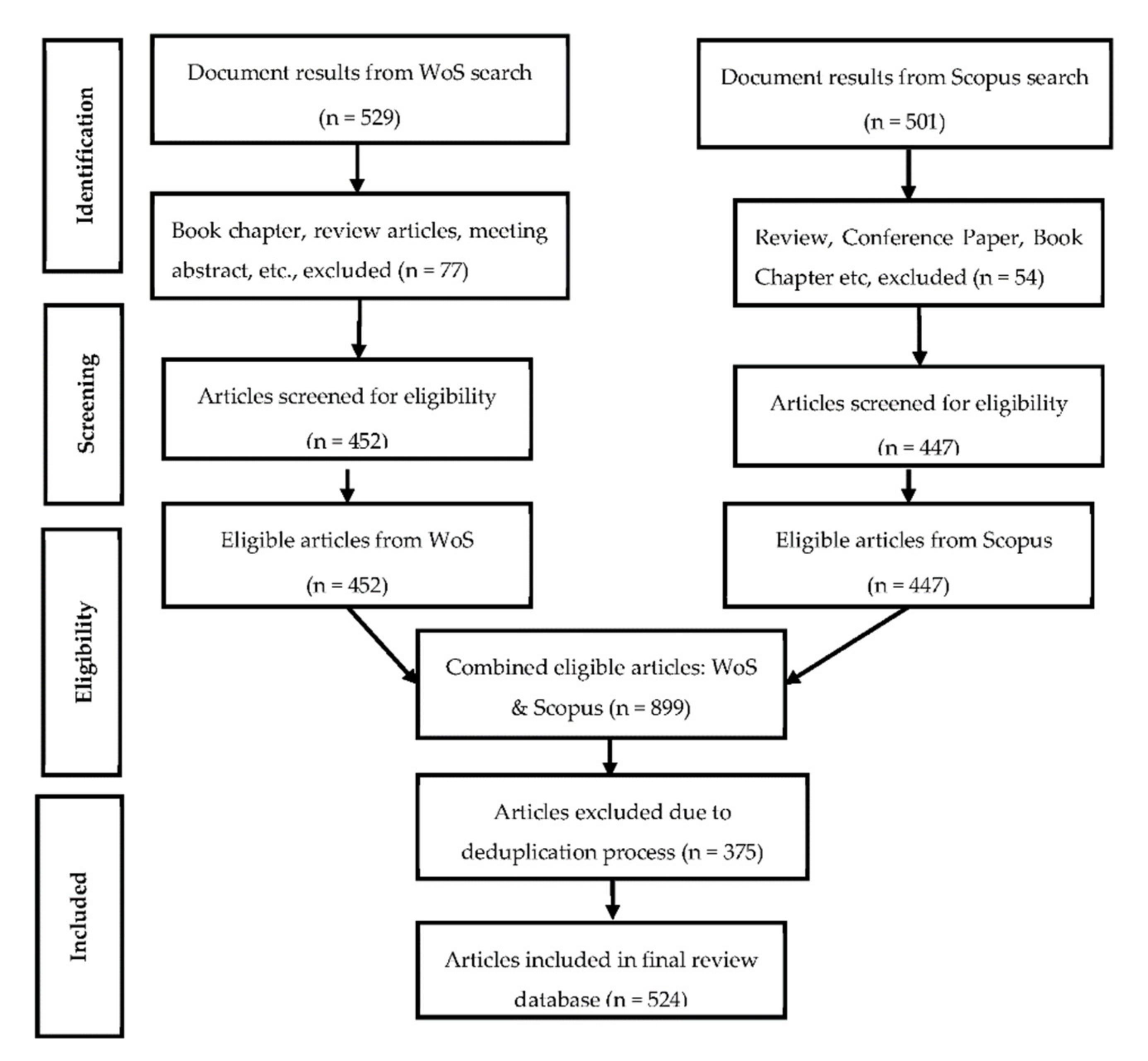
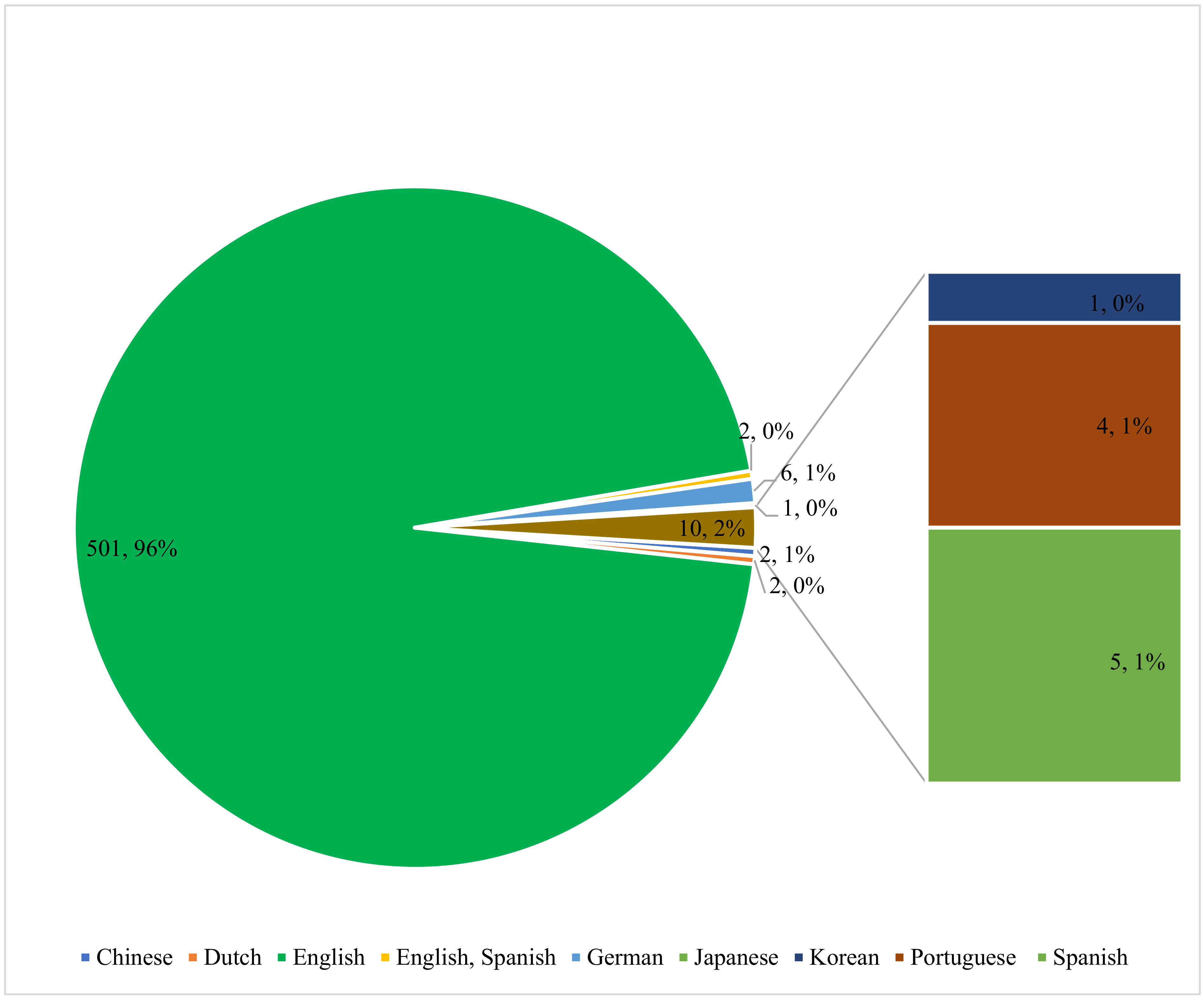

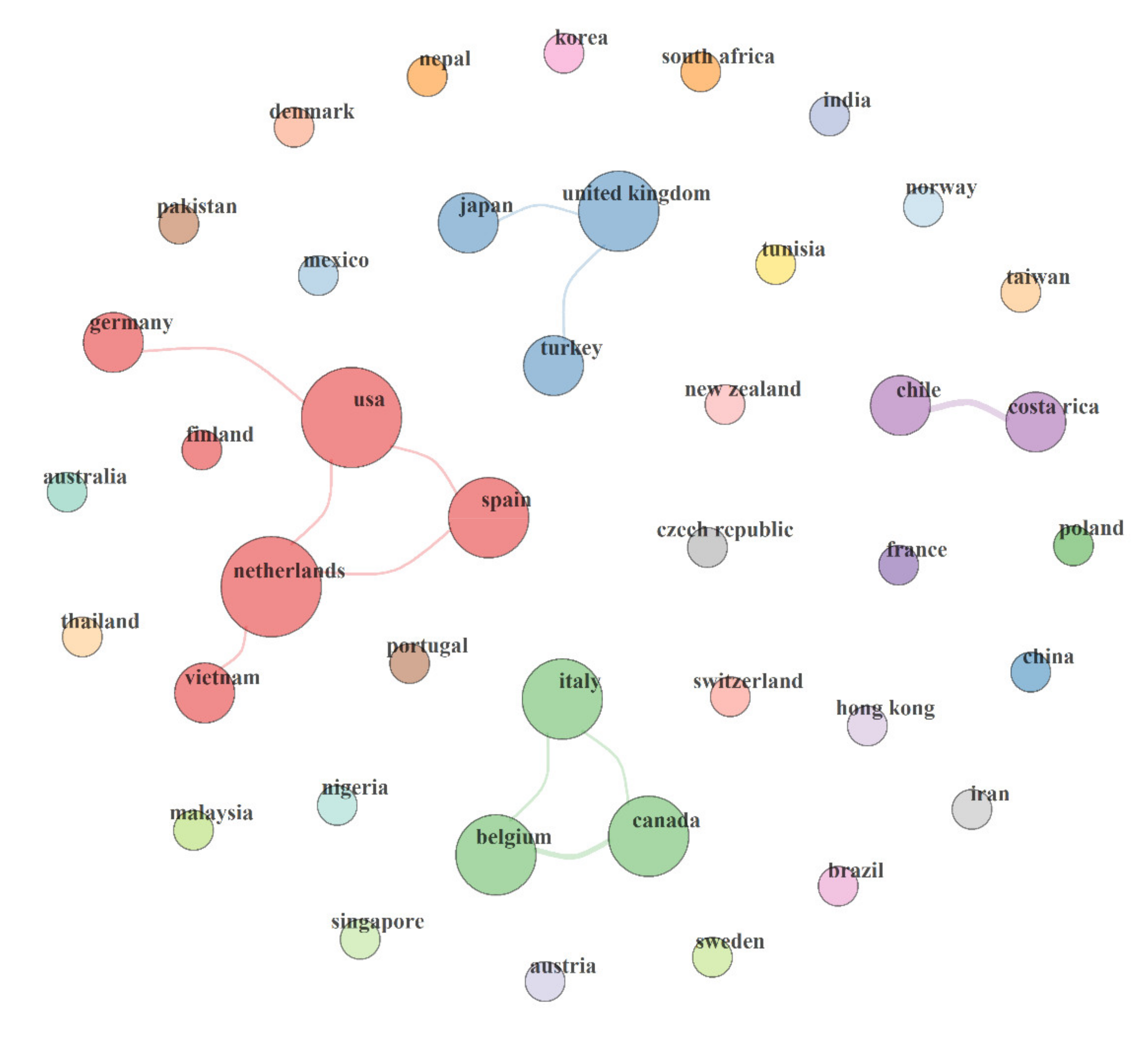
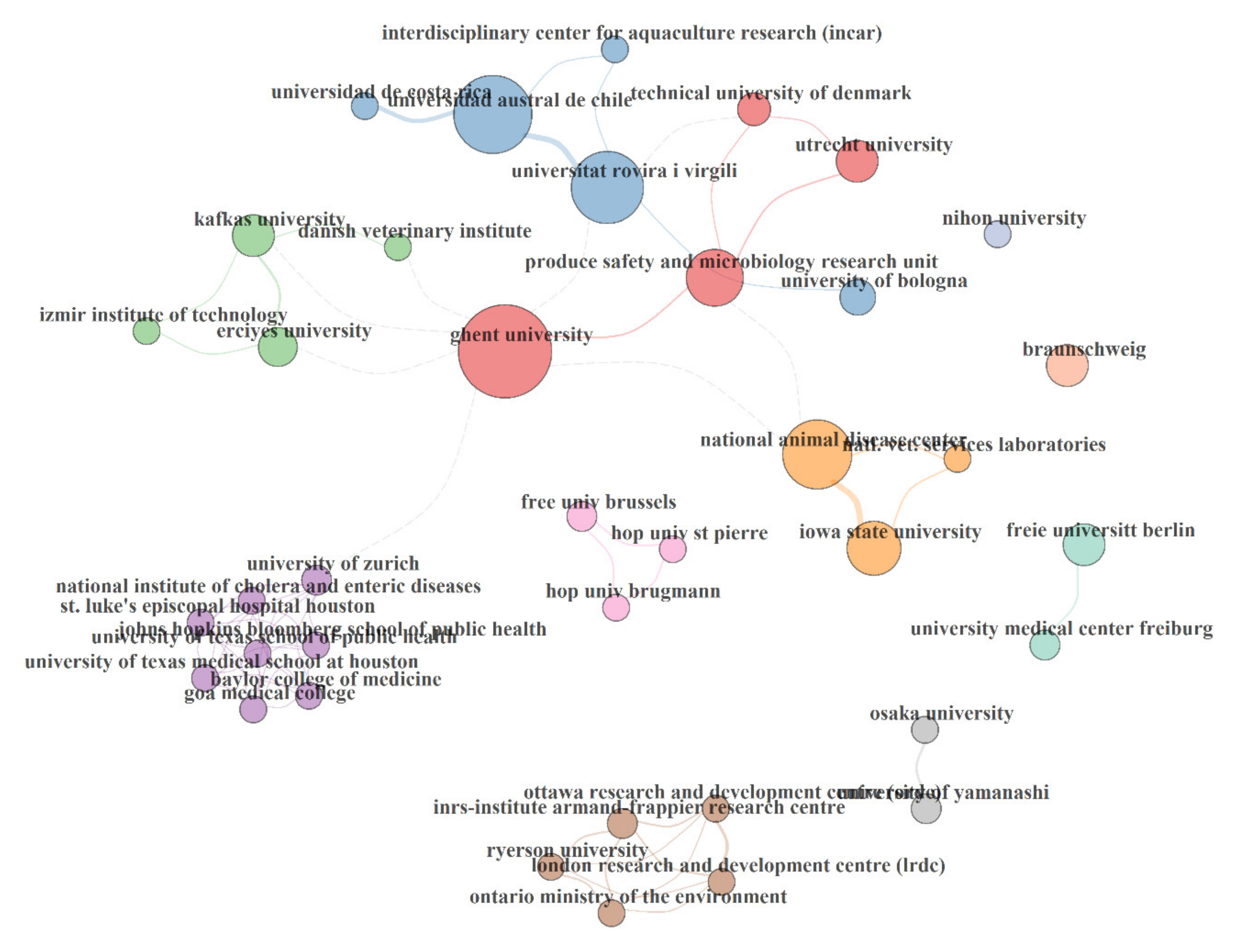
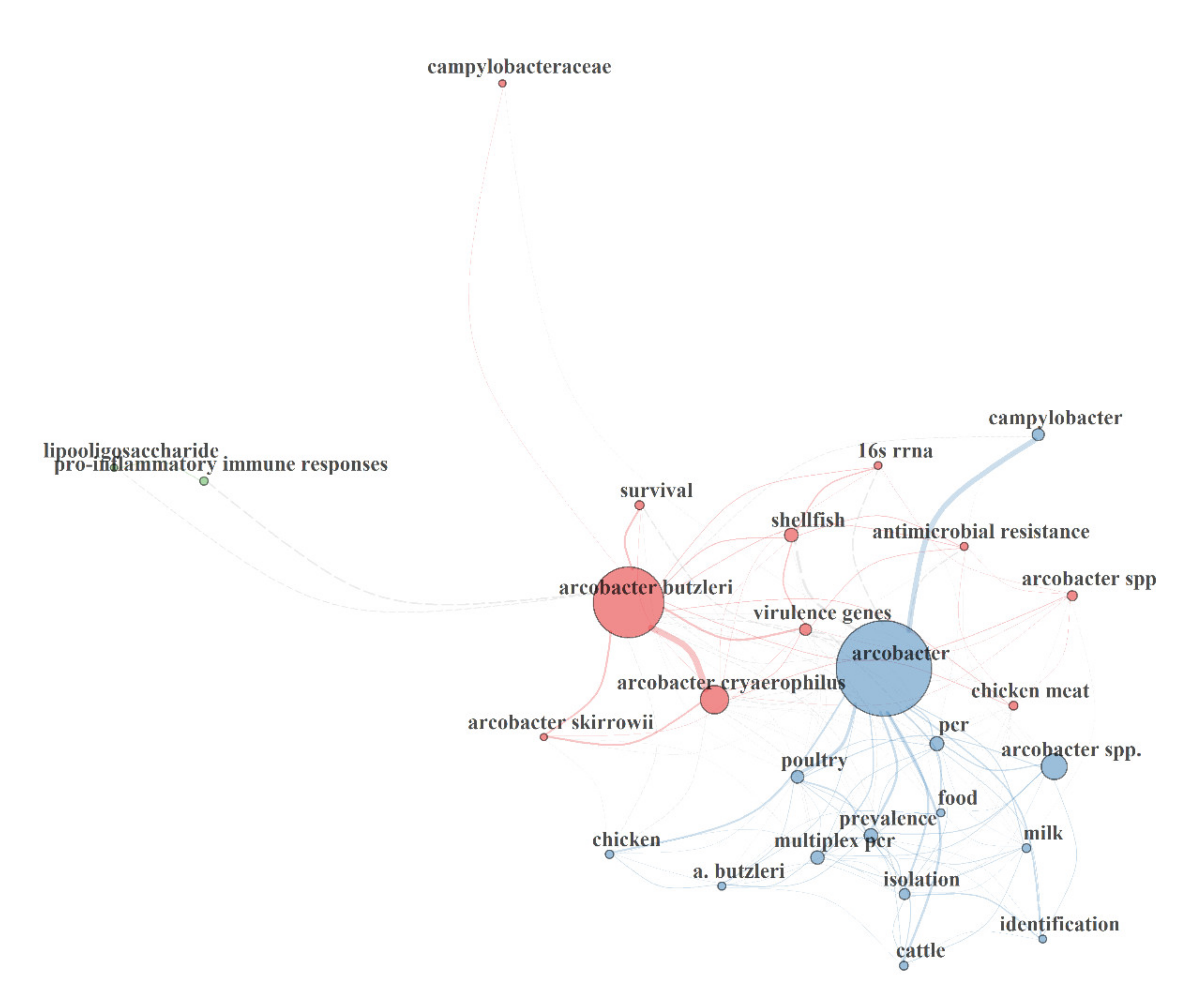
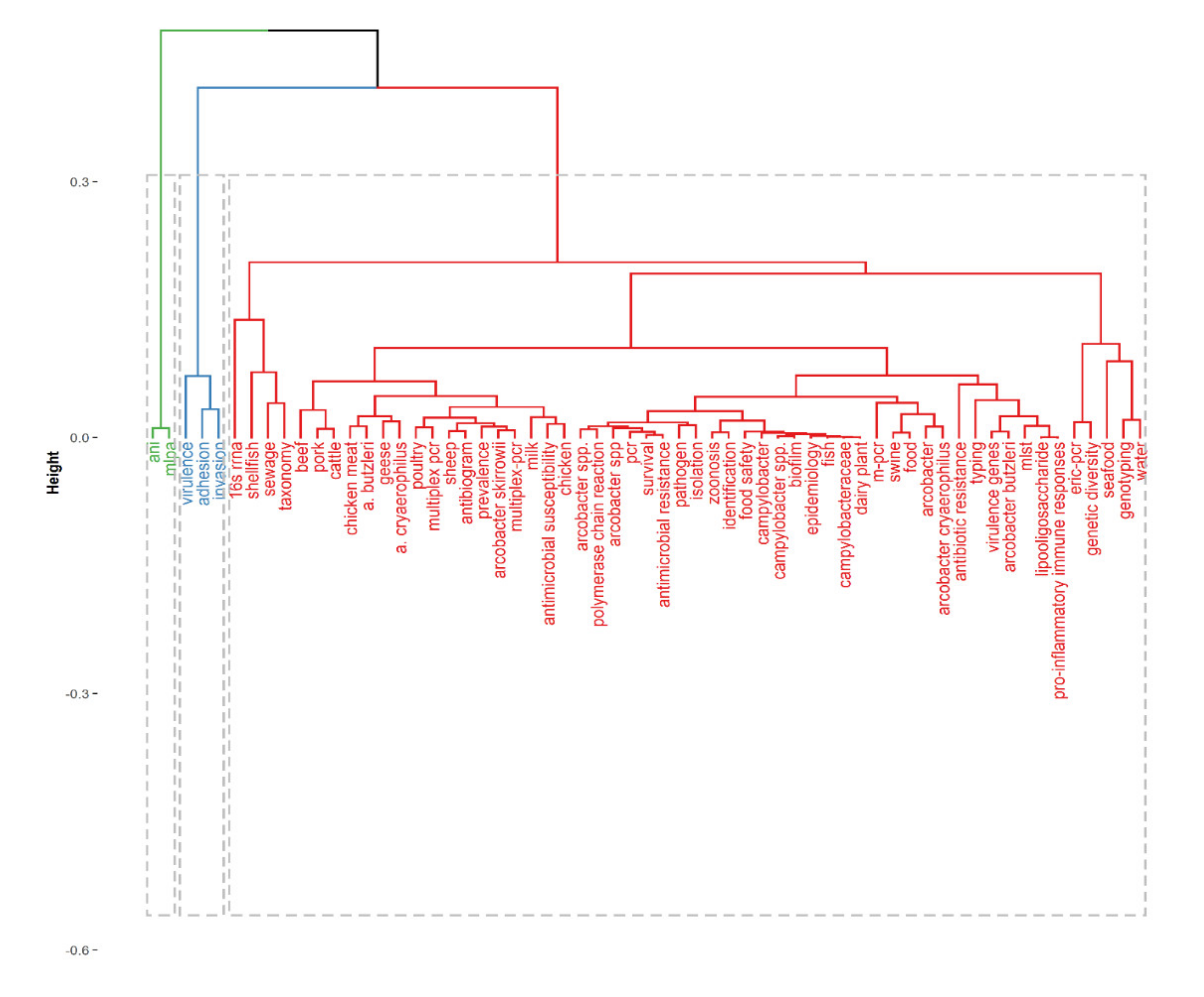

| Information | Counts/Rates |
|---|---|
| Documents | 524 |
| Sources (Journals, Books, etc.) | 172 |
| Keywords Plus (ID) | 2778 |
| Authors’ Keywords (DE) | 671 |
| Average citations per documents | 29.23 |
| Authors | 1304 |
| Author Appearances | 2662 |
| Authors of single-authored documents | 7 |
| Authors of multi-authored documents | 1297 |
| Single-authored documents | 15 |
| Documents per Author | 0.402 |
| Authors per Document | 2.49 |
| Co-Authors per Documents | 5.08 |
| Collaboration Index | 2.55 |
| Document types | |
| Article | 512 |
| Article, book chapter | 9 |
| Article, proceedings paper | 3 |
| Position | Subject | Total | AGR | ADY | PDLY | h-Index |
|---|---|---|---|---|---|---|
| 1 | Microbiology | 264 | −0.7 | 18.3 | 20.8 | 54 |
| 2 | Food Science and Technology | 132 | 1 | 7.3 | 16.7 | 32 |
| 3 | Biotechnology and Applied Microbiology | 128 | −0.7 | 5.7 | 13.3 | 40 |
| 4 | Veterinary Sciences | 51 | −1 | 3 | 17.6 | 18 |
| 5 | Infectious Diseases | 32 | −0.3 | 1.7 | 15.6 | 21 |
| 6 | Agriculture | 18 | −0.3 | 0.7 | 11.1 | 9 |
| 7 | Immunology | 16 | 0 | 0.7 | 12.5 | 12 |
| 8 | Biochemistry and Molecular Biology | 11 | −0.3 | 0.7 | 18.2 | 7 |
| 9 | Science and Technology–Other Topics | 10 | −1 | 0.7 | 20 | 7 |
| 10 | Pharmacology and Pharmacy | 9 | −0.3 | 1 | 33.3 | 6 |
| 11 | Chemistry | 8 | 0 | 0 | 0 | 4 |
| 12 | Public, Env. and Occupational Health | 6 | −0.3 | 0 | 0 | 5 |
| 13 | Toxicology | 6 | 0 | 0 | 0 | 3 |
| 14 | Environmental Sciences and Ecology | 5 | −0.7 | 0 | 0 | 5 |
| 15 | Research and Experimental Medicine | 5 | −0.3 | 0 | 0 | 5 |
| 16 | Gastroenterology and Hepatology | 3 | 0 | 0.3 | 33.3 | 2 |
| 17 | General and Internal Medicine | 3 | 0 | 0 | 0 | 3 |
| 18 | Parasitology | 3 | −0.3 | 0.3 | 33.3 | 3 |
| 19 | Water Resources | 3 | 0 | 0.3 | 33.3 | 2 |
| Position | Authors | PUB | h-Index | TC | PDLY | PY_Start |
|---|---|---|---|---|---|---|
| 1 | Houf K. | 40 | 26 | 2020 | 7.7 | 2000 |
| 2 | Figueras M. | 32 | 19 | 1280 | 25 | 2008 |
| 3 | Vandamme P. | 32 | 25 | 2646 | 8.7 | 1992 |
| 4 | Wesley I. | 26 | 19 | 1184 | 0 | 1995 |
| 5 | Atabay H. | 23 | 14 | 760 | 0 | 1997 |
| 6 | Miller W. | 22 | 8 | 361 | 65 | 2007 |
| 7 | Giacometti F. | 19 | 9 | 198 | 25 | 2013 |
| 8 | Serraino A. | 19 | 10 | 218 | 18.8 | 2013 |
| 9 | Collado L. | 18 | 16 | 1063 | 6.2 | 2008 |
| 10 | De Z. L. | 18 | 15 | 1075 | 0 | 2000 |
| 11 | On S. | 16 | 14 | 1041 | 15.4 | 1995 |
| 12 | Alter T. | 14 | 7 | 136 | 7.1 | 2013 |
| 14 | Fernndez H. | 14 | 7 | 114 | 16.7 | 1995 |
| 15 | Levican A. | 14 | 13 | 590 | 0 | 2011 |
| 16 | Van H. J. | 13 | 13 | 1050 | 0 | 2000 |
| 17 | Yee E. | 13 | 4 | 72 | 91.7 | 2009 |
| 18 | Aydin F. | 10 | 7 | 266 | 12.5 | 2001 |
| 19 | Murano E. | 10 | 9 | 388 | 0 | 1996 |
| Rank | Author | Title | TC | TC/Year |
|---|---|---|---|---|
| 1 | Vandamme et al., 1991 | Proposal for a New Family, Campylobacteraceae | 526 | 18.14 |
| 2 | Vandamme et al., 1992 | Polyphasic Taxonomic Study of the Emended Genus Arcobacter with Arcobacter butzleri comb. nov. and Arcobacter skirrowii sp. nov., an Aerotolerant Bacterium Isolated from Veterinary Specimens | 319 | 11.39 |
| 3 | Engberg et al., 2000 | Prevalence of Campylobacter, Arcobacter, Helicobacter, and Sutterella spp. in Human Fecal Samples as Estimated by a Reevaluation of Isolation Methods for Campylobacters | 257 | 12.85 |
| 4 | Collado et al., 2011 | Taxonomy, Epidemiology, and Clinical Relevance of the Genus Arcobacter | 241 | 26.78 |
| 5 | Wirsen et al., 2002 | Characterization of an Autotrophic Sulfide-Oxidizing Marine Arcobacter sp. That Produces Filamentous Sulfur | 225 | 12.5 |
| 6 | Houf et al., 2000 | Development of a multiplex PCR assay for the simultaneous detection and identification of Arcobacter butzleri, Arcobacter cryaerophilus, and Arcobacter skirrowii | 209 | 10.45 |
| 7 | Vandenberg et al., 2004 | Arcobacter Species in Humans | 201 | 12.56 |
| 8 | Wesley et al., 2000 | Fecal Shedding of Campylobacter and Arcobacter spp. in Dairy Cattle | 184 | 9.2 |
| 9 | Vandamme et al., 1992 | Outbreak of recurrent abdominal cramps associated with Arcobacter butzleri in an Italian school. | 159 | 5.68 |
| 10 | Miller et al., 2007 | The Complete Genome Sequence and Analysis of the Epsilonproteobacterium Arcobacter butzleri | 133 | 10.23 |
Publisher’s Note: MDPI stays neutral with regard to jurisdictional claims in published maps and institutional affiliations. |
© 2021 by the authors. Licensee MDPI, Basel, Switzerland. This article is an open access article distributed under the terms and conditions of the Creative Commons Attribution (CC BY) license (https://creativecommons.org/licenses/by/4.0/).
Share and Cite
Iwu, C.D.; Ekundayo, T.C.; Okoh, A.I. A Systematic Analysis of Research on Arcobacter: Public Health Implications from a Food–Environment Interphase Perspective. Foods 2021, 10, 1673. https://doi.org/10.3390/foods10071673
Iwu CD, Ekundayo TC, Okoh AI. A Systematic Analysis of Research on Arcobacter: Public Health Implications from a Food–Environment Interphase Perspective. Foods. 2021; 10(7):1673. https://doi.org/10.3390/foods10071673
Chicago/Turabian StyleIwu, Chidozie Declan, Temitope Cyrus Ekundayo, and Anthony Ifeanyin Okoh. 2021. "A Systematic Analysis of Research on Arcobacter: Public Health Implications from a Food–Environment Interphase Perspective" Foods 10, no. 7: 1673. https://doi.org/10.3390/foods10071673
APA StyleIwu, C. D., Ekundayo, T. C., & Okoh, A. I. (2021). A Systematic Analysis of Research on Arcobacter: Public Health Implications from a Food–Environment Interphase Perspective. Foods, 10(7), 1673. https://doi.org/10.3390/foods10071673






